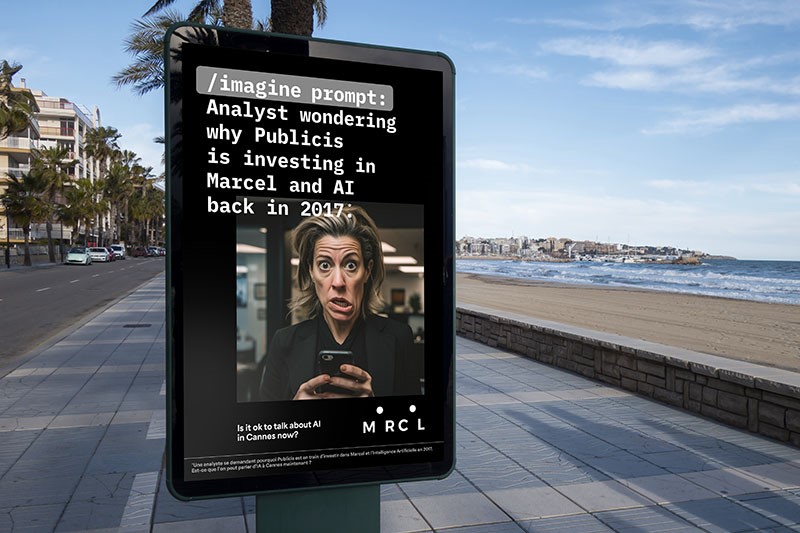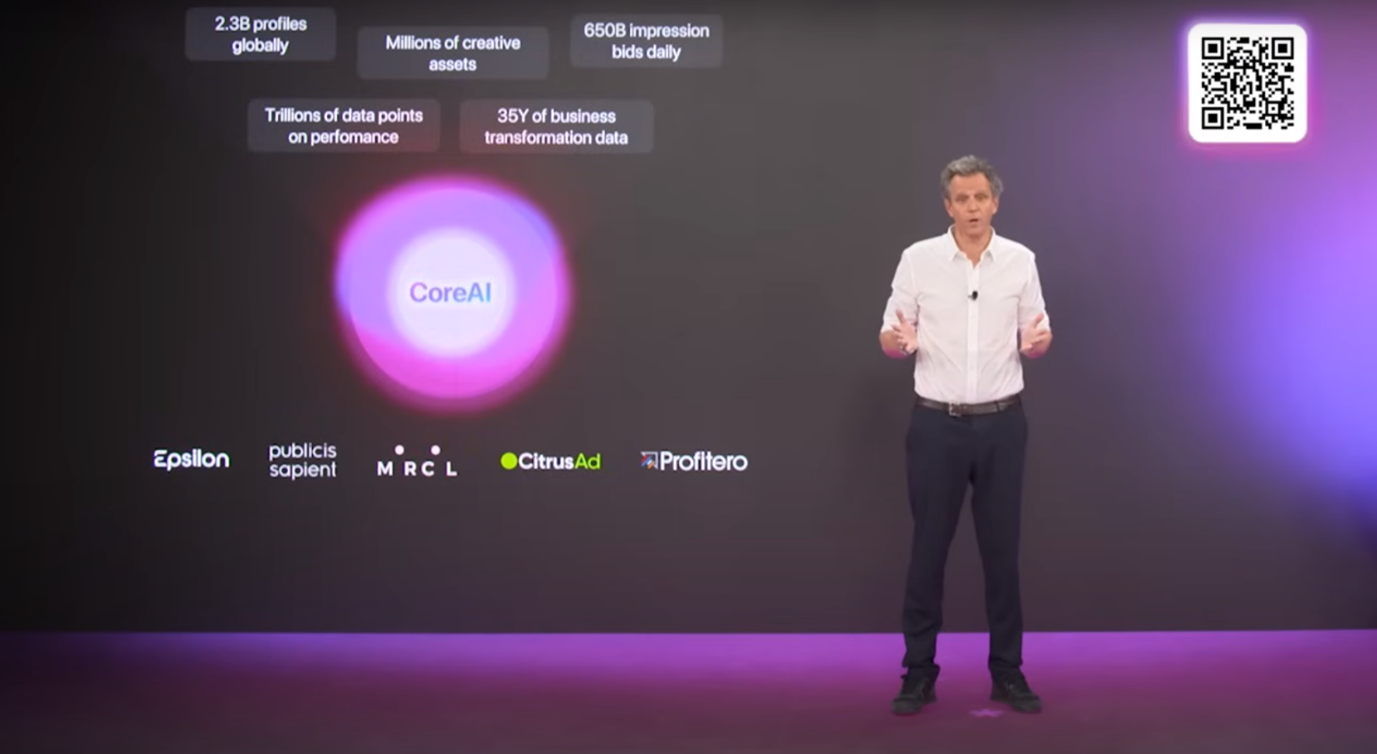


"AI is the most transformative technology of our time, but its real power lies in how it can be applied to amplify human ingenuity. That's the beauty of Marcel and what makes our collaboration with Publicis so seamless and natural."
--Satya Nadella, CEO Microsoft.
A key element of the strategy behind the Polar Capital Artificial Intelligence Fund is to invest in not just artificial intelligence (AI) enabling companies, but the applications and beneficiaries of AI across all sectors. It is this approach that sets us apart from peers concentrating more on AI functionality itself. We see the opportunity for tremendous value creation beyond the technology sector and the ability to invest in the disruptive AI winners, as well as avoiding the many companies that will be negatively impacted, as being key.
An example of where we have seen this advantage already begin to play out is in the advertising sector.
Past disruption prompting AI readiness now
Advertising agencies are all too familiar with existential disruption and the threat of disintermediation in the face of technological advancements, namely potential and existing customers plugging straight into platforms like Google and Facebook and bypassing the incumbent model of employing advertising agencies to reduce spending.
The advent of AI-assisted creative suites has prompted many to revisit this, under the assumption that the shift to online ads, already weighing on agencies’ top-line growth, should mean campaigns become even easier to prepare and manage in-house.
The sector seemingly stands at a crossroads, with agencies having to re-showcase their value to clients and shareholders, over and above what in-house generative AI (GenAI) products could achieve without them. Those unable to do so risk losing business and having to deploy capital from ever-reducing coffers to catch up with sector leaders able to retain and attract clients. This could prompt greater divergence within the sector, with the winners reaping market share and extending their capabilities, exacerbating the ‘winner takes all’ narrative.
French advertising firm Publicis Groupe serves as an interesting case study in this regard.
Publicis’ AI seeds now showing green shoots
While it is not the only firm in the sector experimenting with AI, Publicis has been a notable outlier in embracing the technology for true business transformation rather than novelty. Its overt adoption of AI, including announcing heavy investment into an internal platform named Marcel, in 2017 provoked “a barrage of naysayers and scepticism… reactions of outrage, jest and negativity…”1 from the industry at the time.
Named after Publicis Groupe founder Marcel Bleustein-Blanchet, the custom AI platform connects the 100,000 staff across Publicis Groupe, using their internal profiles to pair the right internal assets with the right campaign at the right time, optimising existing employees’ skillsets and availability. The early implementation across such a sprawling employee base has not gone unnoticed by partners, some of whom have registered interest for a licensed version.
However, it is not simply Publicis’ initial foray into AI that sets it apart from peers; rather it is its own admission that, seven years on, AI is now a core tenet of its business model, designed to keep the firm’s raison d’être relevant and command an ever-growing lead over competitors.
Having acquired digital transformation business Sapient in 2015 and data technology platform Epsilon in 2019, Publicis is able to help customers navigate and implement AI internally, combine third-party proprietary data with vast datasets to make ads relevant and, importantly, encourage customers to easily fold-in Publicis creative services. As such, its model has evolved to use AI to link business units and efficiently manage and structure the data flowing between
The result of imbuing internal operations with AI efficiencies is an ecosystem called CoreAI. It combines data from all business areas – constantly being added to by staff – offering trillions of data points on marketing content and media performance. Critically, it is accessible and sharable around the company to help develop and scale creative campaigns across geographies and media platforms.
The combination of their vast datasets, powered by Epsilon, and the relative maturity of the offering relative to peers who are earlier with their AI implementations , should, in our view, provide a meaningful platform for outperformance against relatively unprepared competitors. Publicis has positioned itself as a key partner for clients navigating the fast changing and increasingly complex digital ecosystem.
Furthermore, while companies may bring creative functions in-house to cut costs, this does not necessarily translate into more skilled resource or better output. Publicis still draws on a respected creative foundation in its employees and now offers highly refined targeting and innovative approaches, including the type of hyper-personalisation demonstrated by CEO Arthur Sadoun in his individual Christmas messages, in various languages, to 100,000 staff using an internally trained model.
The market opportunity
While we find companies are eager to use AI technologies within their businesses in the hope of one-off efficiency drivers and subsequent near-term revenue uplift, we are more drawn to companies integrating AI for the good of a longer-term business transformation and sector leadership. Our preference for a focus on enhancing the business itself, rather than the top line, attracts us to companies that have already deployed AI programmes long before the excitement and sectoral disruption of the past two years.
Publicis was able to raise its annual revenue forecast three times in 2023 despite some peers cutting guidance, broadly as a result of laying the groundwork for business change seven years ago. While the headline cost of an advert or impression may fall over time, in part through AI tools facilitating lower production costs, projects such as the hyper-personalised content highlighted above, which require the ability to manipulate the largest datasets, could lead to a significant increase in volumes and deliver continued growth in contract sizes and customer wins. A lower upfront ad cost also has the ability to service smaller clients previously priced out of engaging with an agency – opening up a market that is potentially sizeable for the agencies that are able to implement this. It is the companies able to capture both these first and second order impacts presented by AI that offer the most differentiated opportunity versus their peers.
Marcel now serves as a case study for potential customers to test their ability and willingness to use AI meaningfully to improve productivity, rather than as a novel tool. To this end, competitors not yet ready to rollout similar solutions will inevitably have to play catch-up, with the gap likely to grow as Publicis has access to more data, refining its models and offering ever-more personalised and lower cost, higher volume services. While Publicis will not be immune to industry or market challenges, it is unlikely to face the same hurdle in evidencing its AI strategy as competitors, with its early innovation meaning it is less vulnerable to a general malaise within the sector and is more likely to emerge as a longer-term sector leader. Our view is buoyed by recent news of the firm’s plans to spend €300m over the next three years, with no dilutive impact on its operating margin, in a bid to bolster areas from training and recruitment to software and cloud infrastructure; nearly 40% of current staff are engineers.
AI benefits could compound as competitors play catchup
While a shortsighted view of AI beneficiaries beyond technology names may involve looking for immediate revenue uplift after the installation of a new tool or process, we believe the reality of the real winners is more nuanced. AI is playing a meaningful role in improving intra-company efficiency, allowing firms to enhance their own productivity and glean useful insights from ever-growing datasets. It is this opportunity, beyond a superficial AI overlay, that should allow companies embracing AI to improve, generating value through these productivity gains either directly or through increased innovation.
To this end, we believe AI adoption is likely to grow sector dispersion between the early adopters and ultimate beneficiaries, and those hurriedly implementing an AI strategy to keep up rather than as a carefully planned value-add proposition. As such, we are constructive on the opportunity set brought about by pragmatic and meaningful rollouts of AI where the goal is to support the long-term business.
Ultimately, it is the Fund’s ability to invest away from headline AI enablers and into sectors beyond the remit of technology-focused funds that allows us to explore these opportunities for long-term AI value creation. Not only does this allow us to stay nimble, investing in the burgeoning industries AI has yet to create, but it also gives the strategy a broader global equity footprint – again providing a differentiating characteristic compared with more traditional technology funds.
1. Marcel Returns to Cannes Now That It’s ‘OK to Talk About AI’ | Publicis Groupe










